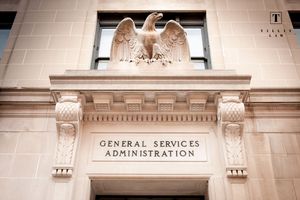Government agencies are required to acquire and use commercially available products and services to the maximum extent practicable. In the implementation of 10 U.S.C. § 3453, government agencies are required to ensure that prime and subcontractors at all levels incorporate commercially available products and services as components of items supplied to the government. Under the Tucker Act, 28 U.S.C. § 1491(b)(1), interested parties are permitted to file suit in the Court of Federal Claims (COFC) challenging (1) a solicitation issued by a federal agency, (2) an award or a proposed award of a contract, or (3) any alleged violation of statute or regulation in connection with a procurement or a proposed procurement. The Federal Acquisition Streamlining Act (FASA) of 1994 contains a “task order bar” that removes from Tucker Act coverage any protests in connection with the issuance or proposed issuance of task or delivery orders that are below the monetary threshold of $35M for defense procurements and $10M for non-defense procurements.
On June 7, 2024, in Percipient.AI v. U.S. (23-1970), the Court of Appeals for the Federal Circuit (CAFC) addressed the interplay of these statutes to carve out a new rule conferring standing upon manufacturers of commercially available products and services to bring a protest alleging harm to their direct economic interests due to the government’s violation of 10 U.S.C. § 3453 – when their product or service has a substantial chance of meeting the government’s needs, either partially or completely, and when they take care not to directly or indirectly challenge the solicitation, contract award, or proposed contract award. The decision may be of particular interest to commercial software manufacturers that produce software in emerging sectors that satisfy at least some of the government’s solicited requirements in large-value procurements. In Percipient.AI, the National Geospatial-Intelligence Agency (NGA) issued the “SAFFIRE” solicitation contemplating a single award Indefinite Delivery, Indefinite Quantity (IDIQ) contract to sustain and improve its processes for obtaining and storing visual intelligence data and integrating those capabilities with a form of user-facing artificial intelligence (AI) called computer vision (CV). The NGA simultaneously solicited Task Order 1 of the IDIQ, which, in pertinent part, directed the contractor to develop and deliver the CV suite of systems. While the protestor produced commercial software that could meet the government’s CV system requirements, it could not meet the storage component of the contract. Therefore, in reliance on the government’s and the eventual awardee’s anticipated compliance with 10 U.S.C. § 3453, the protestor chose not to bid for or protest the SAFFIRE solicitation or the eventual contract award to a large systems integrator.
Instead, the protestor contacted the NGA and the SAFFIRE awardee and explained the capabilities of its commercial software to perform the CV component of the SAFFIRE contract. The protestor then demonstrated its software to the awardee, and while it received positive feedback regarding its software’s capabilities to meet the CV requirements, the awardee failed to conduct a more technical evaluation of the software. Importantly, the protestor learned of the awardee’s intention to build its own software to meet SAFFIRE’s CV requirements at a technology symposium held a few months later. Armed with this knowledge, the protestor again contacted the NGA and expressed its concerns that the awardee could not objectively evaluate the protestor’s software given its stated intention to self-develop the CV software for SAFFIRE. In response, the NGA set up an internal demonstration and testing of the protestor’s software. While an NGA representative opined after the demonstration that the protestor’s software met all of NGA’s analytic transformation requirements, upon conducting the testing, the NGA explained to the protestor that its software was evaluated as a machine learning platform rather than an analytical tool. NGA notified the protestor that its software was not suited to meet the SAFFIRE requirements and confirmed that it would not be evaluated any further. These seemingly contradictory NGA assessments during the initial demonstration and the later evaluation formed the basis for the protestor’s position that the NGA deliberately failed to evaluate its commercial software’s capability to meet SAFFIRE’s CV requirements. At this stage, the protestor filed an action at the Court of Federal Claims (COFC) under 28 U.S.C. § 1491(b)(1), also known as the “bid protest provision” of the Tucker Act, requesting COFC to enjoin NGA’s alleged violation of its obligations under the procurement statute at 10 U.S.C. § 3453, which mandates preference for commercial products and services to the maximum extent practicable. However, the COFC held that the FASA task order bar applied and dismissed the protest for a lack of subject matter jurisdiction.
In appealing the dismissal to the CAFC, the protestor argued the inapplicability of the FASA task order bar by taking the position that its protest was not in connection with the issuance or proposed issuance of a task or delivery order but rather related to the NGA’s alleged violation of 10 U.S.C. § 3453. The NGA and the awardee argued that the COFC was correct in dismissing the protest for lack of subject matter jurisdiction. In the alternative, the NGA argued that the COFC also lacked subject matter jurisdiction because the protest did not meet the requirements of the third prong of 28 U.S.C. § 1491(b)(1), which only permits interested parties to bring protests alleging violation of statute or regulation when the violation at issue is in connection with a procurement or a proposed procurement. Finally, the NGA made a third alternative argument, requesting the CAFC to affirm the COFC’s dismissal of the protest due to the protestor’s lack of standing and one of its claims as an untimely challenge to the terms of the SAFFIRE solicitation.
- Subject Matter Jurisdiction
In ruling that the COFC had subject matter jurisdiction over the protest, the CAFC determined that the protest was:
- Outside the FASA task order bar, and
- Within the jurisdictional limits of the Tucker Act.
o FASA Task Order Bar
The FASA task order bar at 10 U.S.C. § 3406(f)(1) prohibits protests “in connection with the issuance or proposed issuance of a task or delivery order” unless the protest alleges that the task order increases the scope, period, or maximum value of the master contract under which it was issued, or if the task order meets a minimum monetary threshold. The CAFC analyzed each of the four claims in the protestor’s complaint and agreed with the protestor that the FASA task order bar did not preclude the COFC from exercising jurisdiction over the protest as the protestor’s complaint did not assert the wrongfulness of the issuance or proposed issuance of any task orders. In discussing each of the four claims, the CAFC concluded that the facts in the present case were distinct from its decision in SRA International, Inc. v. United States, 766 F.3d 1409, 1413 (Fed. Cir. 2014), where the protestor indirectly challenged the issuance of the task order by challenging the government action of waiving an organizational conflict of interest (OCI). CAFC determined that since none of the protestor’s claims in the protest challenged the issuance of the task order to the awardee but instead only alleged the NGA’s and the awardee prime contractor’s violation of the 10 U.S.C. § 3453, the FASA task order bar did not apply. In conducting a plain meaning analysis of 10 U.S.C. § 3406(f), the CAFC found the government’s interpretation of the FASA task order bar as far too broad, noting that the government’s interpretation was incorrect because it gave no meaning to the phrase “issuance or proposed issuance” within the statute. Thus, CAFC ruled that by not challenging the issuance of the task order to the awardee and instead only asserting the government’s and the prime contractor’s violations of a procurement statute,10 U.S.C. § 3453, the protestor avoided the FASA task order bar.
o Statutory Violations as Basis for Tucker Act Jurisdiction
The CAFC then determined that the allegations of statutory violations by the protestor, that is, the government and the awardee’s violation of 10 U.S.C. § 3453 and its related regulations, were sufficient to establish Tucker Act jurisdiction under the third prong of 28 U.S.C. § 1491(b)(1). As a reminder, the third prong of 28 U.S.C. § 1491(b)(1) allows protests by interested parties for “any alleged violation of statute or regulation in connection with a procurement or a proposed procurement.” The NGA argued that the protest was outside the scope of the Tucker Act as only the issuance of task orders and any acquisition-related decisions related to such issuances were actions that could be considered “procurement” actions for the purposes of the third prong of 28 U.S.C. § 1491(b)(1). The NGA argued that all other actions should be considered contract administration or performance actions outside the scope of the Tucker Act. Therefore, according to the NGA, any alleged violations of 10 U.S.C. § 3453 and its related regulations committed by it or the awardee due to a failure to evaluate the protestor’s commercial software for the CV portion of the SAFFIRE contract – could not be described as “procurement” actions for the purposes of the third prong of 28 U.S.C. § 1491(b)(1).
However, the CAFC disagreed with the NGA’s position, stating that the phrase “in connection with” in the third prong of 28 U.S.C. § 1491(b)(1) was “very sweeping in scope” and that the word “procurement” encompassed all stages of the procurement lifecycle from the determination of the requirement until contract completion and closeout. Therefore, the CAFC ruled that the phrase “in connection with a procurement or proposed procurement” in 28 U.S.C. § 1491(b)(1) held a broader meaning than the one proposed by the NGA. The Court further elaborated that this was especially true when the jurisdiction conferring statute was read in the context of 10 U.S.C. § 3453, which required the government, the prime contractors, and all lower-tier subcontractors to continue maximizing the acquisition of commercial items well after the contract award. Therefore, the protestor’s allegations that the NGA and the awardee violated 10 U.S.C. § 3453 were sufficient in this instance to establish the basis for Tucker Act jurisdiction under the third prong of 28 U.S.C. § 1491(b)(1).
- Standing
After determining that COFC had subject matter jurisdiction over the protest, the CAFC addressed the issue of standing under 28 U.S.C. § 1491(b)(1). The CAFC admitted that while its previous decisions had defined an “interested party” for standing purposes in the context of a protest challenging a solicitation, contract award, or proposed contract award – it had not defined an “interested party” in the context of a protest that exclusively alleges violation(s) of statute or regulation in connection with a procurement or a proposed procurement pursuant to the third prong of 28 U.S.C. § 1491(b)(1). In creating a new rule with potentially far-reaching protestor standing implications, including implications relating to the ability of potential subcontractors to bring protests, the CAFC held that a prospective offeror that is a manufacturer of commercial items has standing under 28 U.S.C. § 1491(b)(1) when it alleges that violations of 10 U.S.C. § 3453 (or potentially other procurement-related statutes) affected its direct economic interest, without directly or indirectly challenging a solicitation for or actual or proposed award of a government contract. In other words, a manufacturer of commercial items that have a substantial chance of being acquired to meet the needs of the government would have standing under the third prong of 28 U.S.C. § 1491(b)(1) when they assert a violation of 10 U.S.C. § 3453 by the government, or the prime contractor, without challenging the solicitation or the contract award. In expanding protestor standing under this specific circumstance, the CAFC also noted that standing under 28 U.S.C. § 1491(b)(1) was different from the scope of protests under the Competition in Contracting Act (CICA) because CICA does not include protests related to the third prong of 28 U.S.C. § 1491(b)(1).
- Timeliness of Improper Delegation of Inherently Governmental Authority Argument
Finally, in the third of four counts in the protestor’s complaint, the protestor had alleged that the NGA unlawfully delegated inherently government authority to the awardee by permitting it to determine whether to utilize commercial or developmental products in the performance of the contract. NGA argued that since this count of the protest related to a patent error in the solicitation, it should have been brought before the submission of proposals pursuant to CAFC’s decision in Blue & Gold Fleet, L.P. v. United States, 492 F.3d 1308, 1313 (Fed. Cir. 2007). In other words, since the protestor did not raise this argument during the solicitation period, it essentially waived its right to protest it once the proposals were submitted. Consistent with its reasoning in this decision, the CAFC disagreed with the government, again clarifying that the protestor was not challenging the terms of the solicitation but rather the post-award delegations of authority by the NGA. Therefore, the CAFC determined that the protestor’s allegations relating to the improper post-award delegation of authority were timely raised, and the matter was reversed and remanded to the COFC for further proceedings.
The CAFC’s decision in Percipient.AI is a crucial one as it confers standing upon potential subcontractors to bring protests under prong three of 28 U.S.C. § 1491(b)(1) when certain conditions are met. However, when such potential subcontractors allege violation(s) of a statute in connection with a procurement or proposed procurement, they must remember not to challenge the solicitation, contract award, or the proposed contract award, as doing so would likely raise issues relating to the connection between privity and the general unavailability of standing for potential subcontractors. Any complaints that establish standing in such litigation may, of course, benefit from the discovery process to further support their allegations. Therefore, the Percipient.AI decision should, at least in theory, increase government agencies and their prime contractors’ compliance with 10 U.S.C. § 3453, although the facts of this case were somewhat unique since the protestor was able to learn about the awardee’s intentions to develop an in-house solution for the CV portion of the SAFFIRE contract at a technology symposium – and was therefore able to allege specific facts about the government and the awardee’s alleged non-compliance with 10 U.S.C. § 3453. At TILLIT LAW, we will be following developments in this area closely, especially for clarifications relating to the level of specificity with which any potential subcontractors would have to allege violations of 10 U.S.C. § 3453 to establish standing under prong three of 28 U.S.C. § 1491(b)(1).
This Bid Protests Insight provides a general summary of the applicable law in the practice area and does not constitute legal advice. Contractors wishing to learn more are encouraged to consult the TILLIT LAW PLLC Client Portal or Contact Us to determine how the law would apply in a specific situation.





